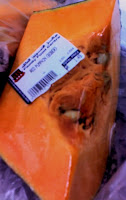Omm Ali, Umm Ali – there are many variations to its spelling - is a delicious mixture of baked puff pastry (or phyllo dough), raisins, nuts (almonds, pistachios, walnuts and/or pine nuts), and sometimes coconut, all covered with a thick sweet cream and baked until golden. It is similar to bread pudding, but richer and made without eggs. Properly made, it is a piece of heaven in a bowl. Creamy but not too rich with bits of dried fruits and nuts. But I also have had many horrible renditions. Poorly made ones resemble soggy, sugary leftover cereal and milk – and taste of the same.
Omm means mother in Arabic, so Omm Ali literally means Ali’s mother. In the Arab culture it is not uncommon for people to often forgo their first names after the birth of their first son and be called Omm or Abu (which means father) name of first son instead. Those without sons are sometimes called by the names of their firstborn daughters, but this is not as prevalent.
Now a bit of history about this famous dish. Arabs love folklore and they certainly have a gift of story telling. So whenever I write about a traditional dish, I try to find the story behind it.
Well, most leads pointed to the origin of Omm Ali as being Egyptian and concocted during the reign of the Mamelukes, a military caste originating in Turkey that ruled Egypt from the 13th to 16th centuries. One Egyptian tourism web site claimed this dessert was named after the first wife of the sultan Ezz El Din Aybek. When the sultan died, his second wife had a dispute with the first wife, (Ali’s mom), which resulted with the death of wife number 2. To celebrate, Omm Ali made this dessert, or probably had ordered it to be made by the palace chefs, and distributed it among the people.
Another version was about a sultan, name unknown, who was hunting in the Nile delta and developed a veracious appetite. He stopped in a small village and the peasants, coveting to please him, requested the best cook of the village, Omm Ali to create something. She whipped up something with the only ingredients she had on hand; dried wheat flakes (perhaps pieces of gullash, an Egyptian phyllo-like pastry), raisins, nuts and coconut. She covered it with sugar and milk and put it into the village communal oven. It turned out to be so good that the sultan requested Om Ali’s dessert the next time he visited.
Yet another story is related by Charles Perry, a retired food writer for the Los Angeles Times and an authority on medieval Arab cookery. Eschewing all prior versions, according to him, Omm Ali was a pudding learned from an English nurse named O'Malley.
Hmm...I like the Egyptian versions better.
*~*~*~*~*~*~*~*~*~*~*~*~*~*~*~*~*~*~*~*~*~*~*~*~*~*~*~*~*
Omm Ali
Ingredients
1 package good quality (i.e. made with butter) frozen puff pastry, thawed
1/4 cup golden raisins, or other dried fruit (cherries, apricots etc)
1/4 cup unsalted chopped pistachios
1/4 cup sweetened, flaked coconut (optional)
1 cup milk
1 cup heavy cream
1 can evaporated milk
1/2 can sweetened condensed milk (or to taste)
1 teaspoon vanilla extract, or ¼ teaspoon ground cardamom powder
1/4 cup sliced almonds
Directions
Preheat the oven to 425 degrees F (200 degrees C).
Unroll the puff pastry sheets, and place flat on a baking sheet. Bake for 15 minutes in the preheated oven, or until puffed and golden brown. Remove and allow to cool.
Break the puff pastry into pieces, and place in a large bowl. Add the raisins, pistachios and coconut (if using), and toss to distribute. Pour into a 9x13 inch baking dish and spread evenly.
Pour the milk, cream, evaporated & condensed milks into a saucepan, along with the vanilla or cardamom powder. Stir to combine well. Heat until hot but not boiling. Carefully pour over the pastry & nut mixture in the baking dish. Sprinkle sliced almonds on top.
Bake for 15 minutes. Turn the oven to broil, and broil for 2 minutes or until lightly brown on the top. Remove from the oven and let stand for at least 5 minutes before serving. Serve warm. With whipped cream & caramel sauce if you want to really gild the lily.
























